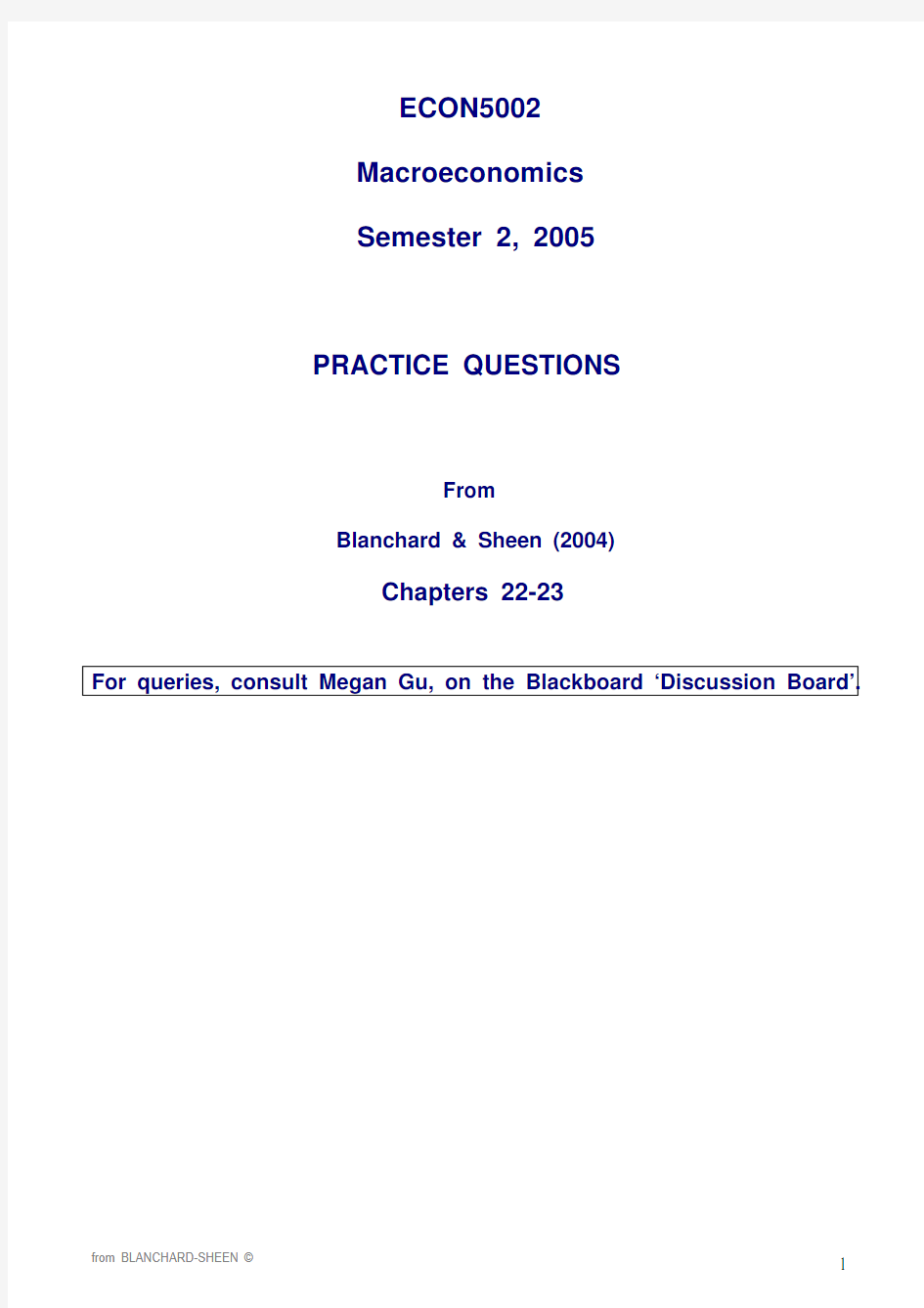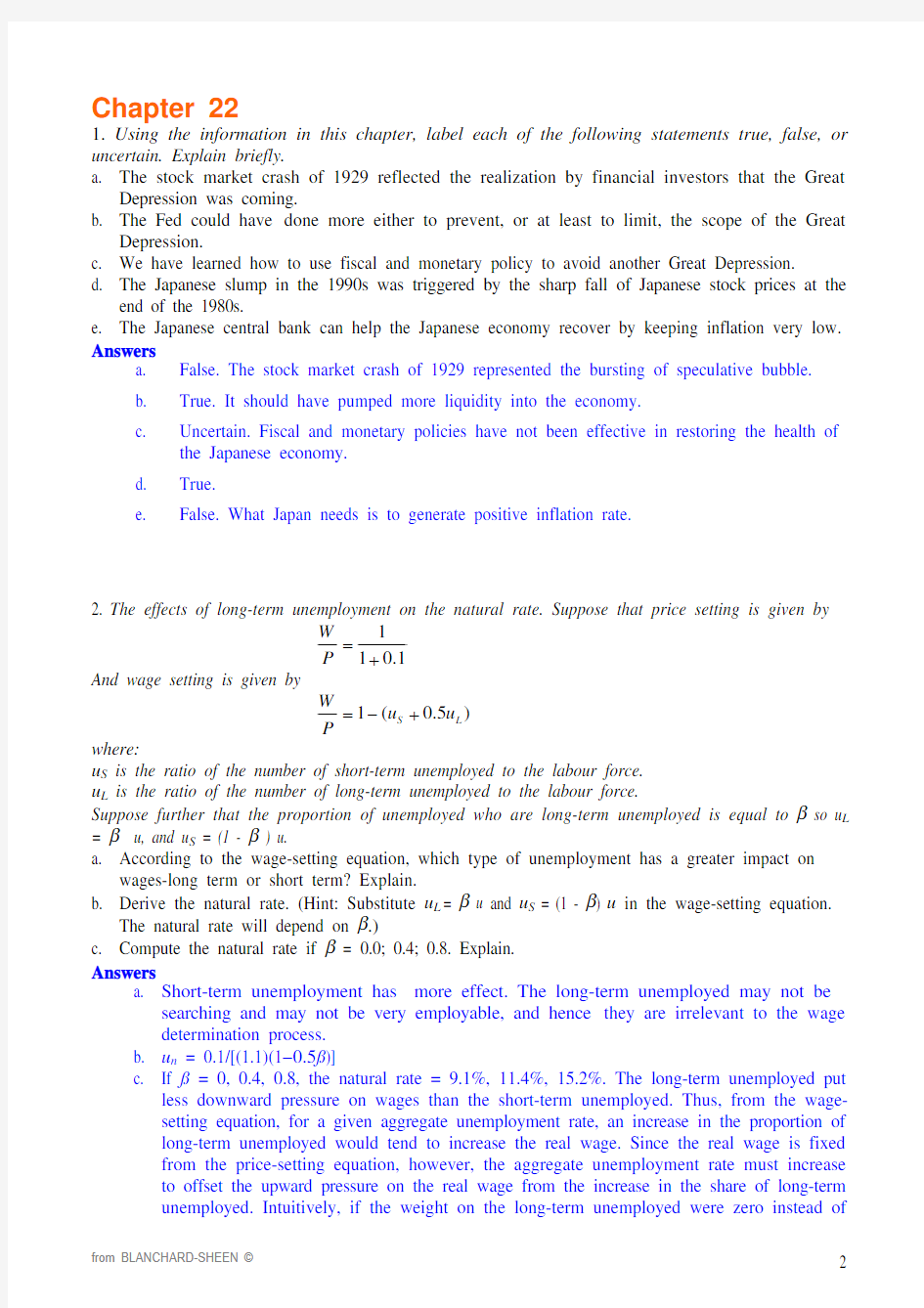ECON5002_Macroeconomics_2007 Semester 2_Answers_to_Practice_Questions_Ch22_23


ECON5002
Macroeconomics
Semester 2, 2005
PRACTICE QUESTIONS
From
Blanchard & Sheen (2004)
Chapters 22-23
For queries, consult Megan Gu, on the Blackboard ‘Discussion Board’.
Chapter 22
1. Using the information in this chapter, label each of the following statements true, false, or uncertain. Explain briefly.
a. The stock market crash of 1929 reflected the realization by financial investors that the Great Depression was coming.
b. The Fed could have done more either to prevent, or at least to limit, the scope of the Great Depression.
c. We have learned how to use fiscal and monetary policy to avoid another Great Depression.
d. The Japanese slump in the 1990s was triggered by the sharp fall of Japanese stock prices at the end of the 1980s.
e. The Japanese central bank can help the Japanese economy recover by keeping inflation very low. Answers
a. False. The stock market crash of 1929 represented the bursting of speculative bubble.
b. True. It should have pumped more liquidity into the economy.
c. Uncertain. Fiscal and monetary policies have not been effective in restoring the health of the Japanese economy.
d. Tru
e. e. False. What Japan needs is to generate positive inflation rate.
2. The effects of long-term unemployment on the natural rate. Suppose that price setting is given by
1
.011+=P W And wage setting is given by
)5.0(1L S u u P
W +?= where:
u S is the ratio of the number of short-term unemployed to the labour force.
u L is the ratio of the number of long-term unemployed to the labour force.
Suppose further that the proportion of unemployed who are long-term unemployed is equal to β so u L = β u, and u S = (1 - β ) u.
a. According to the wage-setting equation, which type of unemployment has a greater impact on wages-long term or short term? Explain.
b. Derive the natural rate. (Hint: Substitute u L = β u and u S = (1 - β) u in the wage-setting equation. The natural rate will depend on β.)
c. Compute the natural rate if β = 0.0; 0.4; 0.8. Explain.
Answers
a. Short-term unemployment has more effect. The long-term unemployed may not be
searching and may not be very employable, and hence they are irrelevant to the wage determination process.
b. u n = 0.1/[(1.1)(1?0.5?)]
c. If ? = 0, 0.4, 0.8, the natural rate = 9.1%, 11.4%, 15.2%. The long-term unemployed put
less downward pressure on wages than the short-term unemployed. Thus, from the wage-setting equation, for a given aggregate unemployment rate, an increase in the proportion of long-term unemployed would tend to increase the real wage. Since the real wage is fixed from the price-setting equation, however, the aggregate unemployment rate must increase to offset the upward pressure on the real wage from the increase in the share of long-term unemployed. Intuitively, if the weight on the long-term unemployed were zero instead of
0.5, then the wage-setting and price-setting equations would determine the natural short-
term rate of unemployment. Additional long-term unemployed would simply increase the aggregate unemployment rate. The same kind of reasoning applies here, but the effect is less strong because the weight on long-term unemployed in the wage-setting equation is not zero.
4. “The Japanese central bank should simply increase the growth rate of nominal money to get the economy out of its slump.” Discuss.
Brief Answer
? One of the keys to the Japanese economy is create inflation and/or generate inflationary
expectations.
?The Bank of Japan (BoJ) could announce an inflation target, a rate of inflation it will try to achieve over the next few years. With the interest rate being so low and close to zero, the general public may not be confident in BoJ’s ability to generate inflation.
?The monetary policy could instead follow a money growth target by steadily increasing the monetary base in the economy; thus stimulating aggregate demand and raising the general price level.
?It could continue to sell Yen and buy foreign exchange reserves, thus pushing down the Yen and stimulating the economy
Chapter 23
1. Using the information in this chapter, label each of the following statements true, false, or uncertain.
Explain briefly.
a. In the short run, governments can finance a deficit of any size through money growth.
b. The inflation tax is always equal to seignorage.
c. Hyperinflations may distort prices, but have no effect on real output.
d. The solution to ending hyperinflations is simple: Institute a wage and price freeze, and inflation
will stop.
e. As inflation is generally good for those who borrow money, hyperinflations are the best times in
which to take out large loans.
f. Budget deficits usually shrink during hyperinflations.
Answers
a. True. Equivalently, the government can generate any amount of seignorage it wants
in the short run.
b. False. Seignorage is equal to inflation tax when the nominal money growth is
constant and the inflation rate eventually converges towards the nominal money growth
rate in the medium run.
c. False. The distortions in the economy adversely impacts consumption and
investment, and thus the real output.
d. Fals
e. Refer to the discussion on other elements required for a successful stabilisation
program.
e. False. The volatility of inflation becomes larger during hyperinflation. Given that
you borrow at a particular nominal interest rate, the uncertainty of the actual real interest
rate that you are repaying is greater, which deters borrowing and lending.
f. False. A ballooning budget deficit is a precursor to hyperinflation.
2. Assume that money demand takes the following form :
)](1[e r Y P
M π+?= where Y = 1000 and r = 0.1.
a. Assume that, in the short run, πe is constant and equal to 25%. Calculate the amount of seignorage if the rate of money growth, ?M/M , equals:
1. 25%.
2. 50%.
3. 75%.
b. In the medium run, πe = π = ?M/M . Compute the amount of seignorage associated with the three rates of money growth in question (a). Explain why the answers differ from those in (a).
Answers
Seigniorage = (?M /M )(M /P ) = (?M /M )(Y [1?(r +πe )])
a. If money growth = 25%, 50%, 75%, seigniorage = 162.5, 325, 487.5
b. In the medium run, if money growth = 25%, 50%, 75%, seigniorage = 162.5, 200, 112.5.
The fall in real money balances associated with higher ongoing inflation reduces the potential for seigniorage. Part 2(a) did not allow for this effect.
3. How would each of the following change the Tanzi-Olivera effect?
a. Requiring monthly instead of yearly tax payments by households.
b. Assessing greater penalties for under-withholding of taxes from monthly paychecks.
c. Decreasing the income tax, and increasing the sales tax.
Answers
a. Would decrease the effect of inflation on real tax revenues.
b. Would decrease the effect of inflation on real tax revenues.
c . Woul
d decreas
e the effect o
f inflation on real tax revenues, but would also have other effects such as distributional effect. The income tax can tax the rich at a higher rate than the poor, but the sales tax rate is the same for the rich and the poor.
4. You are the economic adviser to a country suffering from a hyperinflation. Discuss the following statements made by politicians debating the proper course for stabilization:
“This crisis will not end until workers begin to pay their fair share of taxes.”
“The central bank has demonstrated that it cannot responsibly wield its power to create money, so we have no choice but to adopt a currency board.”
“Price controls are necessary to end this madness.”
“Stabilization will only be successful if there is a large recession and a substantial increase in unemployment.”
“Let’s not blame the central bank. The problem is fiscal policy, not monetary policy.”
Answers
The end to the crisis depends on shifting the composition of taxes. Workers are already paying an inflation tax.
The central bank must make a credible commitment that it will no longer automatically monetise the government debt. Although a currency board would do this, it is a drastic and perhaps unnecessary step.
Price controls may help, but price controls without other policy changes only cause distortions and are a recipe for failure.
A recession is not needed, but it may happen. Although nominal rigidities are less important during hyperinflations—which implies that the sacrifice ratio is small—the issue of credibility remains. Unless firms and workers believe in the stabilisation program, a severe recession may be the result.
The problem has two parts: (i) there is an ongoing fiscal deficit that the government is unable or unwilling to finance from non-monetary sources and (ii) the central bank is willing to monetise the debt. The order in which these issues are resolved ultimately depends on the political realities. The fiscal authority could eliminate the deficits. If it does not do so, the central bank could commit not to monetise government debt. However, this could drive the government into default on its bonds.
